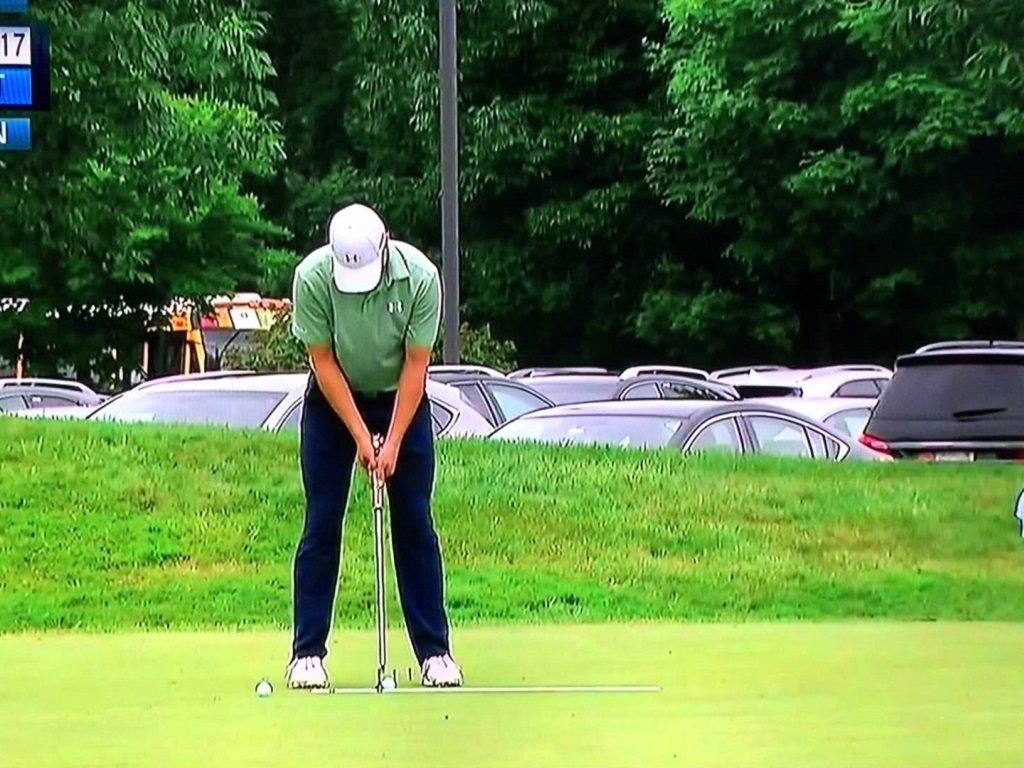News
Does weight affect aim?

Why Speed Dictates Aim
When it comes to putting, and more importantly holing putts, there are only a few factors that are truly going to make a difference when it comes down to it. Technique aside, Speed is going to be one of the biggest influencers on the probability of making the putt. The reason for this is because Speed is going to determine the line you aim the ball on. A putt with less pace is going to break more than a putt of equal distance with more pace.
In addition to Speed being an important contributor to the line you select, it also affects the size of the golf hole that you are putting towards. The hole doesn’t really change size, however, once the golf ball goes into motion, the holes “effective size” changes. Essentially, at rest the golf ball can cross any threshold of the hole and fall in, thus making the holes “effective size” 100%. However, once the ball is placed into motion and is traveling at 1.68MPH the “effective size” of the hole decreases to 75%.
1.68 MPH, Entry Speed, 1-foot past the hole on an 8 stimp meter green, or 2-feet past the hole on a 14 stimp meter green, they all represent the same thing, your best chance to make the putt while giving you the best chance at a kick-in on your next attempt should you miss. Entry speed is a relatively new term, however, is a concept that has been around for a long time.
Real World Application
Mr. Smith is an average golfer and routinely shoots in the mid 80’s at his local course from the regular tees. Mr. Smith decides he wants to put in some work on his short game, and set’s about making more putts from 10-feet and closer. Mr. Smith knows that the practice green has some slope and undulation and picks a putt that breaks from left-to-right at a 2% grade. Mr. Smith putts 10 tries and makes 4 of them from 10 feet. Out of the 6 that missed, only one was missed on the low side of the hole with all of the other putts missed on the “pro” or high side of the hole. The balls that missed on the high side of the hole all came to rest between 3-5 feet past the hole. Based off of traditional knowledge, he feels confident that if he just aims a little more right on those left to righters, he is sure to make more on the next batch. Will Mr. Smith make more than 4 putts out of the next 10 attempts while aiming slightly more to the right?
Mr. Smith could potentially make more putts by aiming more to the right and maintaining his current speed, however, by aiming more “directly” at the hole he has created a more downhill putt which will also increase the Effective Stimp making the ball roll farther past the hole should it miss. Therefore, while we may increase make percentage some, the putts that are missed will be farther from the hole when they come to rest increasing the risk and likelihood of a three-putt.
What would be most beneficial to Mr. Smith would be working on speed control and using the slope and undulation to his advantage. Mr. Smith is like most golfers and routinely misses putts only to blame the line, when in actuality, it was the speed that caused the putt to miss the hole.
Why is Speed Control to Blame?
Some athletes see more curve, and some swear that they only see straight lines. Either way both are at a disadvantage if they are trying to putt the ball to the apex of the break. The reason for this is because the ball will begin to move off of the aim line very quickly as the break takes effect on the ball, and in most cases with breaking putts, the aim line will be outside or farther away from the hole then the actual apex of the break due to this initial breaking prior to reaching the apex.
With that said, using our previous example of Mr. Smith, when the average golfer sees the ball miss left of the hole on a left-to-right breaking putt, they assume that they “pulled’ the putt, when in actuality, they had to strike the putt much to firmly to get the ball to the apex of the break which is what caused it to not take the break at the end of the putt and go in the hole.
Now that we understand that most golfers are hitting the putt with too much pace and not playing enough break, how do we fix this problem? One way to approach this problem would be working with a coach and identifying the areas of speed control (length of stroke, force application, tempo, centeredness of contact, etc.) that need the most work and then develop a training plan to change the motion pattern. Another way, from a club fitting perspective would be to look at how the Instrument is weighted throughout and how that matches and affects the biomechanics of the athlete.
The Heavier the Putter the Better, right?
When you pick up your putter, do you ever balance it on one finger? If so, you know that the “balance point” of the putter tends to be a few inches up the shaft from the club head, and when you find it, you can balance the putter horizontally on one finger. Most putters in the market have most of their mass or weight much closer to the club head then the hands, and this is very important to understand. The more the total mass moves towards one end point, the more the heavier side is going to want to swing relative to the other end point. In engineering, they call this a moment arm.
When we feel how “soft” a putter face is, we are actually experiencing all of our senses and sound tends to affect what we feel a lot. For example, older Ping putters would tend to be lighter and have less mass than current putters, and luckily, they were named Ping because that is the exactly the sound you would get when you struck one. Often times, people would describe a Ping putter as being hard due to it being cast and not forged when in actuality it was due to weight. At the opposite end of the spectrum was the Heavy Putter that was around about 10 years ago. This putter was big and heavy and always felt to be incredibly soft, but in reality, was just a big chunk of lead with lots of mass.
The issue with having a putter that feels great and has a lot of mass is that it tends to hit the golf ball too firmly relative to the perceived “effort” needed to be applied to get the ball to travel to the hole. This leads to putts traveling at too much speed to take the amount of break that we planned on which influences our aim over time.
Perception vs. Reality
Most athletes believe that they prefer a heavy putter, however, when asked about putting, they frequently state that they tend to hit their putts too firmly and miss on the high side of the hole. Based off an understanding of how the weight affects the moment arm and acceleration of the putter, we can see how this is a conflicting ideology. So, if we know that weight contributes to creating the correct “feeling” of the putter for the athlete, yet leads to poor speed control, how do we satisfy both needs?
The answer lies in moving some of the weight or mass to the other side of the center of mass of the putter. The more we “balance out” the weight distribution between the two endpoints, the less moment arm effect will be created. The other advantage to moving mass or weight to the other side of the center of mass of the putter is that we can now satisfy both needs if we are strategic with where the mass or weight is added.
If the center of mass of the putter is a few inches up the shaft from the club head, then if we added mass or weight within the shaft but below the hands, technically the mass or weight is above the center of mass of the putter, yet still below the hands of the athlete which satisfies the “feel” component while still reducing the amount of moment arm effect. This internal weighting can be accomplished using the Opti-Vibe system.
If this attempt at slowing down the club head fails due to the weight of the putter “feeling” too heavy, then we can counter-weight the putter and actually put more mass in the butt-end of the putter. This tends to be very effective in slowing down the club head and many putter manufactures have begun to sell counter-weighted putters. This process can also be completed using a product called Tour Lock.
Summation
Speed kills, and most of us are much too aggressive with our putting strategy, which exposes us to longer “come-back” putts and leads to a higher likelihood of 3-putts. By better understanding how speed effects the line, we can reduce the number of total putts taken by reducing the amount of 3-putts. This is a much easier task to accomplish than having to make more putts outside of 10-feet.
If you are interested in seeing this concept in action, I highly recommend our Big Tilt Pro Max XL. Not only does it project the aim line, but also the maximum speed, minimum speed, and maximum percentage to make line. In addition to being able to see the lines, it also comes with over 50 different training programs designed not only to help with making more putts, but also developing all the necessary skills that go into becoming a good putter.
In addition to training the necessary skills to become a good putter, it is also important to evaluate your putter from a few different perspectives. In addition to creating the proper alignment and loft scenario at address, it is also important to evaluate the weight distribution of the putter and how that affects the timing or tempo of the stroke. While the timing or tempo will be unique for each individual, most good putters will maintain the same timing or tempo when hitting putts from different lengths, which is impossible to do with a putter that is either too light or too heavy. It is important to understand that you probably don’t need a new putter, just a little fine tuning with the weighting.
Fine tuning this process is very easy with the use of the Trackman 4 Putting Solution. By understanding the “fine details” of how we deliver the putter, and how this matches the biomechanics of the body, we can finally get down to working on the parts of the stroke that will have the biggest effect size and actually lead to lower scores.
News
Tour Rundown: Bend, but don’t break

I’m going to gush in this intro paragraph, to get the emo stuff done early. I’ve not pulled harder for a professional to win, than Cameron Young. I coach golf in New York state, and each spring, my best golfers head to a state championship in Poughkeepsie. I first saw Cameron there as a 9th grade student. I saw him three more times after that. I reconnecected with Coach Haas from Wake Forest, an old interview subject from my days on the Old Gold and Black, the Wake newspaper. He was there to watch Cameron. After four years at Wake Forest, Young won on the Korn Ferry Tour, made it to the big tour, almost won two majors, almost won five other events, and finally got the chalice about 25 minutes from the Wake campus. Congratulations, Cameron. You truly are a glass of the finest. #MotherSoDear
OK, let’s move on to the Tour Rundown. The major championship season closed this week in Wales, with the Women’s Open championship. The PGA Tour bounced through Greensboror, N.C., while the PGA Tour Americas hit TO (aka, Toronto) for a long-winded event. The Korn Ferry lads made a stop in Utah, one of just two events for that tour in August. The many-events, golf season is winding down, as we ease from summer toward fall in the northern hemisphere. Let’s bask in the glory of an August sunrise, and run down a quartet of events from the first weekend of the eighth month.
LET/LPGA @ Women’s Open: Miyu bends, but she doesn’t break
Royal Porthcawl was not a known commodity in the major tournament community. The Welsh links had served as host to men’s senior opens, men’s amateurs, and Curtis and Walker Cups in prior years, but never an Open championship for the women or the men. The last-kept secret in UK golf was revealed once again to the world this week, as the best female golfers took to the sandy stage.
Mao Saigo, Grace Kim, Maja Stark, and Minjee Lee hoped to add a second major title to previous wins this season, but only Lee was able to finish inside the top ten. The 2025 playing of the Women’s Open gave us a new-faces gallery from day one. The Kordas and Thitikulls were nowhere to be found, and it was the Mayashitas, Katsus, and Lim Kims that secured the Cymru spotlight. The first round lead was held at 67 by two golfers. One of them battled to the end, while the other posted 81 on day two, and missed the cut. Sitting one shot behind was Miyu Yamashita.
On day two, Yamashita posted the round of the tournament. Her 65 moved her to the front of the aisle, in just her fourth turn around a women’s Open championship. With the pre-event favorites drifting off pace, followers narrowed into two camps: those on the side of an underdog, and others hoping for a weekend charge from back in the pack. In the end, we had a bit of both.
On Saturday, Yamashita bent with 74 on Saturday, offering rays of hope to her pursuing pack. England’s Charley Hull made a run on Sunday closing within one shot before tailing off to a T2 finish with Minami Katsu. Katsu posted the other 65 of the week, on Saturday, but could not overtake her countrywoman, Yamashita. wunderkind Lottie Woad needed one round in the 60s to find her pace, but could only must close-to’s, ending on 284 and a tie with Minjee for eighth.
On Sunday, Yamashita put away the thoughts of Saturday’s struggles, with three-under 33 on the outward half. She closed in plus-one 37, but still won by two, for a first Major and LPGA title.
PGA Tour @ Wyndham: Young gathers first title near home
Cameron Young grew up along the Hudson river, above metro New York, but he also calls Winston-Salem home. He spent four years as a student and athlete at Wake Forest University, then embarked on tour. This week in Greensboro, after a bit of a break, Young opened with 63-62, and revved the engine of Is this the week once more. Runner-up finishes at the Open, the PGA, and a handful of PGA Tour events had followers wonder when the day would come.
On Saturday, Young continued his torrid pace with 65, giving him a five-shot advantage over his closest pursuer. Sunday saw the Scarborough native open with bogey, then reel off five consecutive birdies to remind folks that his time had, at last, arrived. Pars to the 16th, before two harmless bogeys coming home, made Young the 1000th winner of an official PGA Tour event (dating back to before there was a PGA Tour) throughout history. What’s next? I have a suspicion, but I’m not letting on. Mac Meissner closed with 66 to finish solo 2nd, while Mark Hubbard and Alex Noren tied for third.
Korn Ferry Tour @ Utah Championship: Are you Suri it’s Julian?
Who knows exactly when the flower will bloom? Julian Suri played a solid careet at Duke University, then paid his dues on the world’s minor tours for three years. He won twice on two tours in Europe, in 2017. Since then, the grind has continued for the journeyman from New York city. At age 34, Suri broke through in Beehive state, outlasting another grinder (Spencer Levin) and four others, by two shots.
Taylor Montgomery began the week with 62, then posted 64, then 68, and finally, 70. That final round was his undoing. He finished in that second-place tie, two back of the leader. Trace Crowe, Barend Botha, and Kensei Hirata made up the last of the almost quintet. As for Suri, his Sunday play was sublime. His nines were 32 and 31, with his only radar blip a bogey at ten. He closed in style with one final birdie, to double his winning margin. Hogan bloomed late…might Suri?
PGA Tour Americas @ Osprey Valley Open presented by Votorantim Cimentos – CBM Aggregates
Some tournament names run longer than others. This week in Toronto, at the Heathlands course at TPC Toronto, we might have seen the longest tournament title in recorded history. The OVOPBVCCBMA was a splendid affair. It saw three rounds of 62 on Thursday, but of those early risers, only Drew Goodman would stick around until the end. 64 was the low tally on day two, and two of those legionnaires managed to finish inside the top three at week’s end. Saturday brought a 63 from Patrick Newcomb, and he would follow with 64 on Sunday, to finish solo fourth.
Who, then, ended up winning the acronym of the year? It turns out that Carson Bacha had the right stuff in TeeOhhh. Bacha and Jay Card III posted 63 and 64, respectively, on day four, to tie for medalist honors at 23-under 261. Nathan Franks was one shot adrift, despite also closing with 63. If you didn’t go low on Sunday, it was about the check, not the championship.
Bacha and JC3 returned to the 18th hole twice in overtime. Card nearly chipped in from the thick stuff for birdie, while Bacha peeked and shoved a ten-feet attempt at the win. On the second go-round, Card was long with his approach, into the native grasses once more. He was unable to escape, and a routine par from the fairway was enough to earn the former Auburn golfers a first KFT title.
Card III and Bacha both miss their birdie tries on the first playoff hole.
We’ll play 18 again @OspreyOpen. pic.twitter.com/vNpHTdkHDg
— PGA TOUR Americas (@PGATOURAmericas) August 3, 2025
Tour Photo Galleries
Photos from the 2025 Wyndham Championship

GolfWRX is live this week from the final event of the PGA Tour’s regular season, the Wyndham Championship.
Photos are flowing into the forums from Sedgefield Country Club, where we already have a GolfWRX spirit animal Adam Schenk WITB and plenty of putters for your viewing pleasure.
Check out links to all our photos below, which we’ll continue to update as more arrive.

General Albums
- 2025 Wyndham Championship – Tuesday #1
- 2025 Wyndham Championship – Tuesday #2
- 2025 Wyndham Championship – Tuesday #3

WITB Albums
- Chandler Phillips – WITB – 2025 Wyndham Championship
- Davis Riley – WITB – 2025 Wyndham Championship
- Scotty Kennon – WITB – 2025 Wyndham Championship
- Austin Duncan – WITB – 2025 Wyndham Championship
- Will Chandler – WITB – 2025 Wyndham Championship
- Kevin Roy – WITB – 2025 Wyndham Championship
- Ben Griffin – WITB – 2025 Wyndham Championship
- Peter Malnati – WITB – 2025 Wyndham Championship
- Ryan Gerard – WITB – 2025 Wyndham Championship
- Adam Schenk – WITB – 2025 Wyndham Championship
- Kurt Kitayama – WITB – 2025 Wyndham Championship
- Camilo Villegas – WITB – 2025 Wyndham Championship
- Matti Schmid – WITB – 2025 Wyndham Championship
Pullout Albums
- Denny McCarthy’s custom Cameron putters – 2025 Wyndham Championship
- Swag Golf putters – 2025 Wyndham Championship
- Karl Vilips TM MG5 wedges – 2025 Wyndham Championship
- New Bettinardi putters – 2025 Wyndham Championship
- Matt Fitzpatrick’s custom Bettinardi putters – 2025 Wyndham Championship
- Cameron putters – 2025 Wyndham Championship

See what GolfWRXers are saying and join the discussion in the forums.
News
BK’s Breakdowns: Kurt Kitayama’s Winning WITB, 3M Open

Kurt Kitayama just won his 2nd PGA Tour event at the 3M Open. Kurt is a Bridgestone staffer but with just the ball and bag. Here are the rest of the clubs he used to secure a win at the 2025 3M Open.
Driver: Titleist GT3 (11 degrees, D1 SureFit setting)
Shaft: Graphite Design Tour AD VF 7 TX
3-wood: Titleist GT1 3Tour (14.5 degrees, A3 SureFit setting)
Shaft: Graphite Design Tour AD DI 8 TX
7-wood: Titleist GT1 (21 degrees, A1 SureFit setting)
Shaft: Graphite Design Tour AD DI 9 TX
Irons: TaylorMade P7CB (4), TaylorMade P7MB (5-PW)
Shafts: True Temper Dynamic Gold Tour Issue X100
Wedges: Titleist Vokey Design SM10 (52-12F, 56-14F), Vokey Design WedgeWorks (60-K*)
Shafts: True Temper Dynamic Gold Tour Issue S400
Putter: Scotty Cameron Studio Style Newport 2 Tour Prototype
Grip: SuperStroke Zenergy 1.0PT
Grips: Golf Pride Tour Velvet
Ball: Bridgestone Tour B XS (with Mindset)










geohogan
Apr 5, 2022 at 10:08 am
We aim a bow and arrow. We aim a fire arm.
Standing 90 degrees to the target line, it is not possible to “aim” a golf club at a distant target.
We can position ourselves to sweep the inside quadrant of the golf ball.
Wasted my Time
Apr 2, 2022 at 10:37 pm
All these mumbo-jumbo for a sales pitch? Shameful!
lee
Apr 2, 2022 at 9:19 pm
nice ad